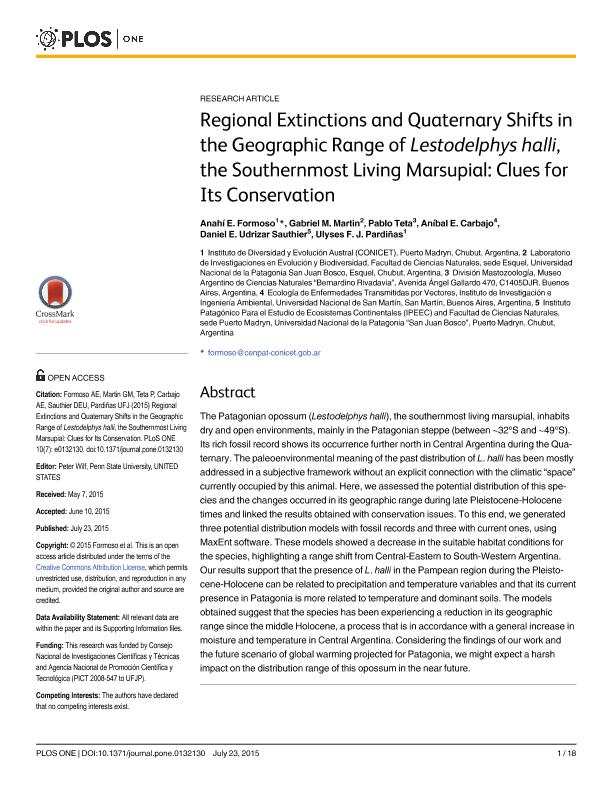Mostrar el registro sencillo del ítem
dc.contributor.author
Formoso, Anahí Elizabeth

dc.contributor.author
Martin, Gabriel Mario

dc.contributor.author
Teta, Pablo Vicente

dc.contributor.author
Carbajo, Anibal Eduardo

dc.contributor.author
Udrizar Sauthier, Daniel Edgardo

dc.contributor.author
Pardiñas, Ulises Francisco J.

dc.date.available
2018-04-09T14:47:07Z
dc.date.issued
2015-07
dc.identifier.citation
Formoso, Anahí Elizabeth; Martin, Gabriel Mario; Teta, Pablo Vicente; Carbajo, Anibal Eduardo; Udrizar Sauthier, Daniel Edgardo; et al.; Regional Extinctions and Quaternary Shifts in the Geographic Range of Lestodelphys halli, the Southernmost Living Marsupial: Clues for Its Conservation; Public Library of Science; Plos One; 10; 7; 7-2015; e0132130
dc.identifier.issn
1932-6203
dc.identifier.uri
http://hdl.handle.net/11336/41308
dc.description.abstract
The Patagonian opossum (Lestodelphys halli), the southernmost living marsupial, inhabits dry and open environments, mainly in the Patagonian steppe (between ~32°S and ~49°S). Its rich fossil record shows its occurrence further north in Central Argentina during the Quaternary. The paleoenvironmental meaning of the past distribution of L. halli has been mostly addressed in a subjective framework without an explicit connection with the climatic “space” currently occupied by this animal. Here, we assessed the potential distribution of this species and the changes occurred in its geographic range during late Pleistocene-Holocene times and linked the results obtained with conservation issues. To this end, we generated three potential distribution models with fossil records and three with current ones, using MaxEnt software. These models showed a decrease in the suitable habitat conditions for the species, highlighting a range shift from Central-Eastern to South-Western Argentina. Our results support that the presence of L. halli in the Pampean region during the Pleistocene-Holocene can be related to precipitation and temperature variables and that its current presence in Patagonia is more related to temperature and dominant soils. The models obtained suggest that the species has been experiencing a reduction in its geographic range since the middle Holocene, a process that is in accordance with a general increase in moisture and temperature in Central Argentina. Considering the findings of our work and the future scenario of global warming projected for Patagonia, we might expect a harsh impact on the distribution range of this opossum in the near future.
dc.format
application/pdf
dc.language.iso
eng
dc.publisher
Public Library of Science

dc.rights
info:eu-repo/semantics/openAccess
dc.rights.uri
https://creativecommons.org/licenses/by-nc-sa/2.5/ar/
dc.subject
Argentina
dc.subject
Holocene
dc.subject
Lestodelphys
dc.subject
Maxent
dc.subject
Past Distribution Model
dc.subject
Patagonia
dc.subject
Patagonian Opossum
dc.subject
Pleistocene
dc.subject.classification
Otras Ciencias Biológicas

dc.subject.classification
Ciencias Biológicas

dc.subject.classification
CIENCIAS NATURALES Y EXACTAS

dc.title
Regional Extinctions and Quaternary Shifts in the Geographic Range of Lestodelphys halli, the Southernmost Living Marsupial: Clues for Its Conservation
dc.type
info:eu-repo/semantics/article
dc.type
info:ar-repo/semantics/artículo
dc.type
info:eu-repo/semantics/publishedVersion
dc.date.updated
2018-03-28T18:12:26Z
dc.identifier.eissn
1553-7390
dc.journal.volume
10
dc.journal.number
7
dc.journal.pagination
e0132130
dc.journal.pais
Estados Unidos

dc.journal.ciudad
San Francisco
dc.description.fil
Fil: Formoso, Anahí Elizabeth. Consejo Nacional de Investigaciones Científicas y Técnicas. Centro Científico Tecnológico Conicet - Centro Nacional Patagónico. Instituto de Diversidad y Evolución Austral; Argentina
dc.description.fil
Fil: Martin, Gabriel Mario. Universidad Nacional de la Patagonia ; Argentina
dc.description.fil
Fil: Teta, Pablo Vicente. Consejo Nacional de Investigaciones Científicas y Técnicas. Oficina de Coordinación Administrativa Parque Centenario. Museo Argentino de Ciencias Naturales ; Argentina
dc.description.fil
Fil: Carbajo, Anibal Eduardo. Universidad Nacional de San Martín; Argentina
dc.description.fil
Fil: Udrizar Sauthier, Daniel Edgardo. Consejo Nacional de Investigaciones Científicas y Técnicas. Centro Científico Tecnológico Conicet - Centro Nacional Patagónico. Instituto Patagónico para el Estudio de los Ecosistemas Continentales; Argentina. Universidad Nacional de la Patagonia; Argentina
dc.description.fil
Fil: Pardiñas, Ulises Francisco J.. Consejo Nacional de Investigaciones Científicas y Técnicas. Centro Científico Tecnológico Conicet - Centro Nacional Patagónico. Instituto de Diversidad y Evolución Austral; Argentina
dc.journal.title
Plos One

dc.relation.alternativeid
info:eu-repo/semantics/altIdentifier/doi/https://dx.doi.org/10.1371/journal.pone.0132130
dc.relation.alternativeid
info:eu-repo/semantics/altIdentifier/url/http://journals.plos.org/plosone/article?id=10.1371/journal.pone.0132130
Archivos asociados
